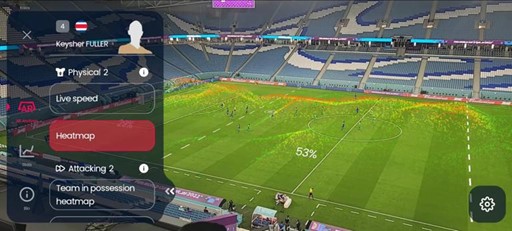
The Dawn of Sports Technology
In 1911, a pioneering event marked the inception of sports broadcasting when 1,000 spectators in Lawrence, Kansas, congregated to witness a live recreation of the Kansas vs. Missouri football game being played miles away in Missouri. Facilitated by Western Union, this early experiment involved telegraphing play-by-play actions from Columbia, Missouri, where the game was hosted, to an eager audience back in Lawrence. This not only captivated the spectators but also set a foundational milestone in sports media, illustrating the profound potential of technology to reshape sports engagement.
Bridging the Gap: The Progressive Integration of Technology in Sports
The evolution of technology in sports, beginning with early telegraphic updates, represents a profound shift towards more immersive and interactive athletic experiences. From the mid-20th century, developments such as photo finishes and electronic timing began to minimize human error in competitive sports, ensuring more precise outcomes. The latter part of the century introduced sports medicine technologies that enhanced injury prevention and recovery, paving the way for less invasive treatments and quicker rehabilitation times.
As the digital age dawned, the 21st century saw a surge in data analytics and wearable technology, dramatically transforming athletes’ training and strategic planning. GPS tracking and motion capture systems started to provide detailed analytics on athlete movements, revolutionizing how teams approached game strategy and player conditioning. This period also marked the integration of computer-aided design (CAD) in equipment manufacturing, which led to more precisely engineered sporting gear tailored to enhance performance and safety.
These advancements set the stage for today’s high-tech sports environment, where real-time data and artificial intelligence inform coaching decisions and tactical adjustments during live games. As we continue to explore the potential of augmented reality (AR) and the Internet of Things (IoT), sports are becoming not just more competitive and safer but also more engaging and accessible to fans around the world.
Ubiquitous Technology in Sports
Today, technology infiltrates every aspect of the sports industry, becoming an indispensable component from training grounds to spectator areas. This widespread integration impacts everything from athlete preparation to the very fabric of fan experiences, transforming how sports are practiced, played, and enjoyed. Sophisticated analytics and wearable devices optimize training and performance, enhancing athlete capabilities and safety. At the same time, innovations in digital engagement platforms are redefining fan participation, making the sporting experience more interactive and immersive. This all-encompassing presence of technology illustrates its pivotal role in evolving sports, improving safety, and enhancing the overall quality of engagement for everyone involved.
1. Ensuring Game Integrity Through Technology
The evolution of officiating in sports has significantly benefited from technological advancements, primarily aimed at preserving the integrity of the game. The adoption of technologies like the Video Assistant Referee (VAR) and goal-line technology in football marks a shift from sole reliance on human judgment to a more accurate and fair decision-making process. These systems provide officials with clear, real-time evidence on critical plays, helping to determine outcomes with greater precision and reducing controversial calls.
Similarly, in tennis, Hawk-Eye technology uses multiple cameras to track the ball’s position for accurate line calls, significantly reducing human error and enhancing the fairness of rulings. The integration of such technologies ensures that the spirit of competition is maintained by prioritizing accuracy and fairness in game outcomes.
Beyond traditional sports, technology is also transforming officiating in other areas. For instance, in cricket, the Decision Review System (DRS) includes infra-red imaging and sound-based sensors to verify the umpire’s calls on potential bat-ball contacts, which are crucial in determining leg-before-wicket (LBW) decisions. This system has been pivotal in correcting on-field mistakes, thereby upholding the integrity of match results.
Cycling has also seen innovations like the use of Radio-Frequency Identification (RFID) chips in bicycles during races to combat bike fraud—ensuring that all competitors are using regulation equipment and providing real-time data on each bicycle’s location during the race. This not only aids in fair competition but enhances the safety measures during high-speed events.
The integration of these technologies ensures that the spirit of competition is maintained by prioritizing accuracy and fairness in game outcomes. Moreover, these technological aids are continuously refined to adapt to the dynamic nature of sports, illustrating a commitment to integrity that resonates across all levels of competitive athletics.
2. Advancing Athlete Performance with Technological Innovations
Technology’s role in enhancing athlete performance has become increasingly crucial in monitoring and optimizing physical output. Wearable devices, such as those used by the Toronto Raptors, exemplify this trend. These devices collect data on athlete biometrics during both games and training sessions, allowing teams to analyze and react to potential injury risks or areas needing improvement. This proactive approach has led to a noticeable reduction in player injuries and optimized athletic performance, setting new standards in sports health management.
There has also been a steady adoption of VR in the industry. Leading NFL teams such as the New England Patriots, Tampa Bay Buccaneers, Dallas Cowboys, Minnesota Vikings, Arizona Cardinals, and New York Jets employ VR solutions from STRIVR. By integrating VR headsets into their training sessions, these teams create realistic gameplay scenarios, allowing athletes to refine their on-field positioning, enhance situational awareness under pressure, and deepen their understanding of plays without the need for physical exertion or the risk of injury. Additionally, scouts can utilize VR technology to evaluate quarterbacks’ decision-making skills by examining their positioning and target accuracy.
 Two major Goal-Line Technologies (GLT) used in Football Officiating (Source: Living2022)
Two major Goal-Line Technologies (GLT) used in Football Officiating (Source: Living2022)
3. Fan Engagement & Digital Experience
Technological advancements have revolutionized fan engagement, transforming spectators from passive observers to active participants in sporting events. One notable innovation was Formula E’s ‘Fanboost’ which allowed fans to vote for their favorite drivers to receive a temporary boost during races. This interactive feature empowered fans to influence the race dynamics directly, though it was later discontinued due to concerns about fairness and potential manipulation.
Beyond individual events, augmented reality (AR) technologies are enhancing the live viewing experience. For instance, during the 2022 FIFA World Cup, the ‘FIFA+ Stadium Experience’ app provided fans with AR overlays of real-time game statistics and player positions directly on their mobile devices. This immersive use of AR allowed fans to engage with the game in innovative ways, enriching their understanding and enjoyment of the action as it unfolded.
 FIFA+ Stadium Experience using live footage to show data through overlays (Source: FIFA)
FIFA+ Stadium Experience using live footage to show data through overlays (Source: FIFA)
Moreover, the rise of smart stadiums is setting new standards in fan experiences. These venues integrate extensive digital infrastructures, such as SoFi Stadium’s wraparound screens and digital twin technology, to offer personalized services and interactive experiences. These technologies not only enhance spectator enjoyment but also optimize stadium operations and safety by analyzing data from previous events to improve future ones.
Debating Technology’s Role in Sports
The integration of technology into sports has sparked significant debate. On one side, critics argue that the pervasive use of technology risks undermining the human element of sports, potentially making the games less engaging and more predictable. They caution that reliance on technology can lead to incorrect decisions that might unfairly affect game outcomes, emphasizing that technology is not infallible and should not replace human judgment. Critics also point to the high cost of cutting-edge technologies, which can create disparities, giving wealthier teams an undue advantage and leaving smaller, less affluent teams at a disadvantage.
Supporters, however, champion the benefits of technology, asserting that it enhances the competitive nature of sports. They contend that technology, by providing detailed performance data, allows athletes and teams to refine their strategies and improve their skills, thus elevating the level of play. Additionally, proponents argue that technology supports and enhances traditional aspects of sports without replacing them, ensuring that fairness and integrity are maintained while enhancing accuracy in officiating and decision-making.
The Future of Sports Technology
As technology continues to evolve, its influence on sports is becoming increasingly transformative, promising to reshape aspects of performance, engagement, and management. According to the book titled ‘The Use of Developing Technology in Sports’ by Özgür Publications, the global sports technology market is on a robust growth trajectory, projected to reach USD 40 billion by 2026. This growth is driven by the integration of advanced technologies that enhance the capabilities of athletes and enrich the experience for fans.
 BioStamp, a band-aid like sensor that captures body data in real-time (Source: USA Today)
BioStamp, a band-aid like sensor that captures body data in real-time (Source: USA Today)
Innovations such as augmented reality (AR) and virtual reality (VR) are set to revolutionize fan engagement by offering immersive experiences that bring spectators closer to the action, regardless of their physical location. For athletes, wearable technology and biomechanical systems continue to advance, providing deeper insights into performance dynamics and health metrics, which can prevent injuries and optimize physical output.
Moreover, AI and machine learning are increasingly employed to refine training programs and game strategies, providing teams with a competitive edge by analyzing vast amounts of data to uncover patterns that would be indiscernible to the human eye. This data-driven approach is enhancing scouting, training, and rehabilitation, pushing the boundaries of what athletes can achieve.
Emerging technologies like Mojo Vision are testing an invisible contact lens with a built-in display that provides cyclists and other athletes with critical information without obstructing their view, highlighting the innovative ways technology integrates seamlessly into sports. Such advancements not only enhance performance but also promise to revolutionize the spectator experience, blending the digital and physical aspects of sports engagement.
Looking ahead, the potential for technology in sports is boundless. Innovations like real-time biometric monitoring and holographic displays could further blur the lines between the digital and physical realms, creating new paradigms for how sports are played, watched, and understood. As the industry navigates these changes, it will be crucial to balance innovation with the traditions and spirit that form the core of sports.
References:
- FIA Formula E (2024)
- Beonair (2023)
- Student Union Sports (2023)
- Özgür Publications (2023)
- FIFA (2022)
- Fujitsu (2022)
- Forbes (2022)
- Aol (2022)
- FIFA (2022)
- CNET (2022)
- Los Angeles Times (2022)
- Living2022 (2020)
- Ertheo (2017)
- USA Today (2016)




